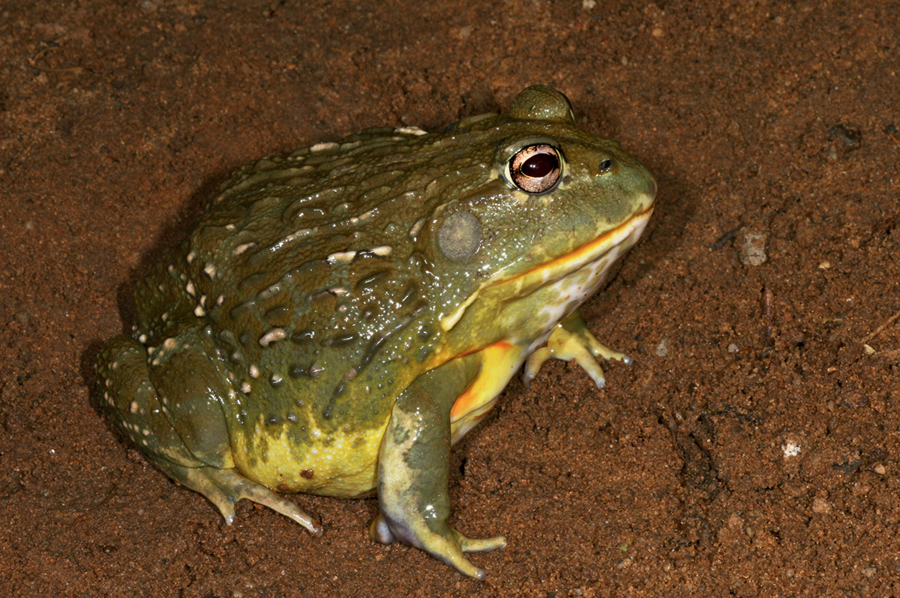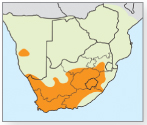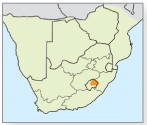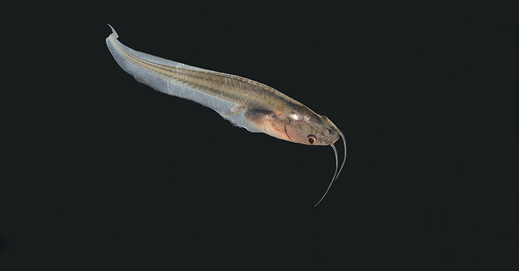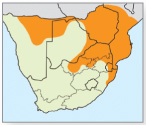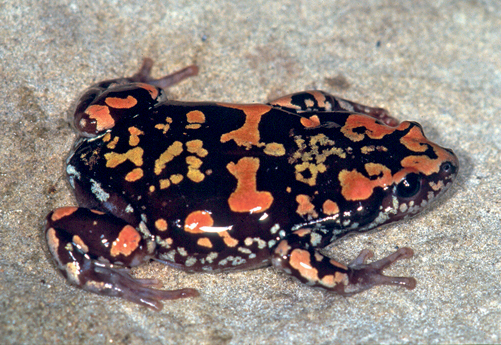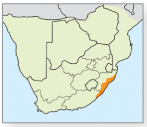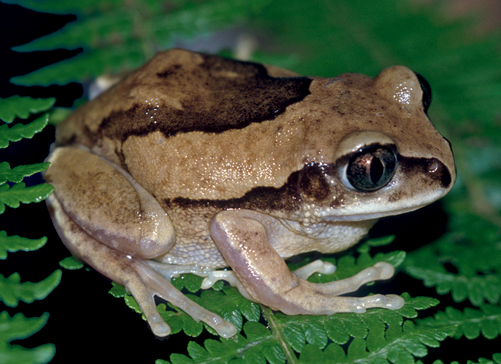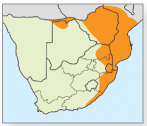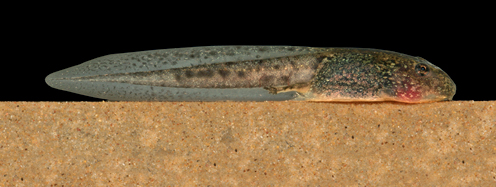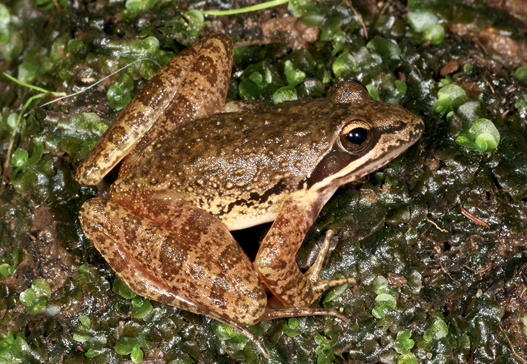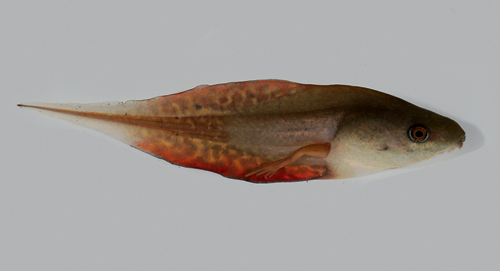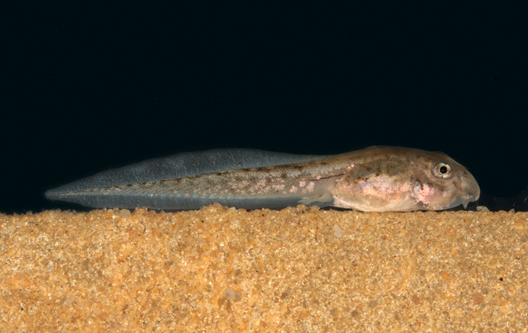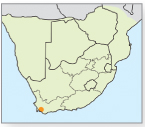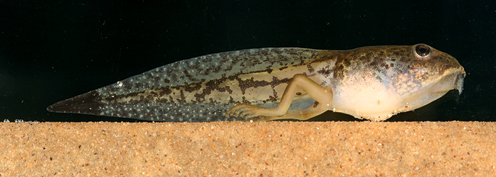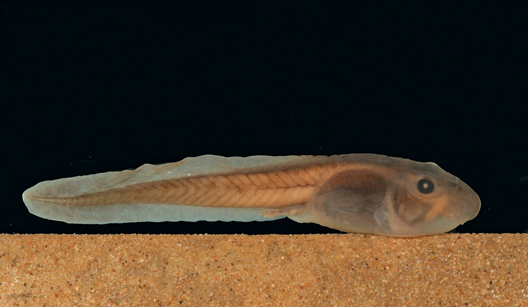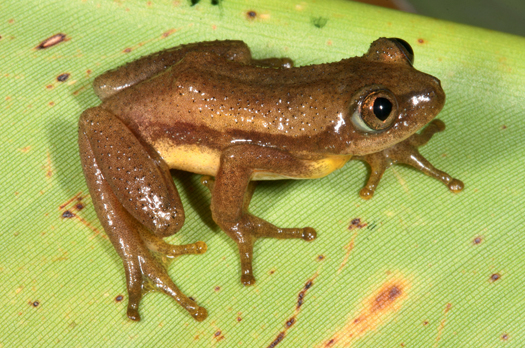4 |
Text by Louis du Preez and Vincent Carruthers |
|
Amphibians
Class Amphibia
Amphibians comprise three orders – Anura (frogs and toads), Caudata (newts and salamanders) and Gymnophonia (worm-like amphibians) – of which only Anura occur in southern Africa. They have two phases to their life cycle: an aquatic tadpole and a terrestrial adult. Approximately 6,000 species occur globally, of which 163 are found in southern Africa. The 95 species described in this chapter are wetland-dependent, having free-swimming tadpoles and requiring open surface water to breed. Sizes given represent average adult length from snout to vent; however, individual variation may be considerable. Frog calls, made by males to attract females, are unique and are the most reliable method of identification in the field.
Frogs and tadpoles have exacting microhabitat requirements, and habitat modification affects them directly. Their amphibious life cycle exposes them to both the aquatic and terrestrial environments, and their porous skin makes them vulnerable to environmental change. They are therefore useful indicators of the healthy functioning of wetland systems.
The rigid keratin (hardened skin) mouthparts of tadpoles form ‘jaw sheaths’ that are important identification characteristics and are described by means of the following ‘labial tooth row formula’ (LTRF), which is given at the end of each entry, where applicable:
LTRF = Number of rows of teeth in upper jaw (row numbers of those rows that are divided in the middle)/number of rows of teeth in lower jaw (row numbers of those rows that are divided in the middle)
Row numbers are counted from the top.
Thus, in the species illustrated here:
 The upper jaw has five rows, of which rows 2–5 are divided.
The upper jaw has five rows, of which rows 2–5 are divided. The lower jaw has four rows, of which rows 1 and 2 are divided.
The lower jaw has four rows, of which rows 1 and 2 are divided.
Thus, the LTRF formula is: 5(2–5)/4(1–2).
Bullfrogs
Genus Pyxicephalus
Largest frogs in the region; spend most of the year immobile and aestivating, buried in cocoons of dried skin that protect them from desiccation. Up to 4,000 eggs are laid, and tadpoles aggregate into tight schools in shallow warm water. Before and after breeding, adult bullfrogs feed on insects, other frogs, lizards, snakes, small birds and rodents.
1 Giant bullfrog
Pyxicephalus adspersus
Olive green, with ridges of whitish skin and no patterning on face. Underside smooth, creamish yellow, sometimes with grey. Orange in groin and armpits. Distance between eye and tympanum greater than diameter of tympanum. Juveniles up to 50mm in length, mottled emerald green and black. Size: 115mm. Biology: Breeds in shallows of temporary rain-filled depressions. Emerges briefly to breed after first substantial rainfall. Males (1a) form leks (aggregations) where they compete aggressively, calling and mating for only 1–2 days. Call a deep slow bellow lasting a full second. Unique among local frogs in showing parental care. Males remain with tadpoles and attack intruders. When necessary they can dig canals to deeper water to save tadpoles trapped in drying pools (1b). Tadpole up to 71mm. Robust plump body. Tail fin reaches deepest point just behind middle of tail (1c). Jaw sheaths slender; strongly flexed. LTRF 4(3–4)/3. RELATED SPECIES: African bullfrog (P. edulis) (1d) lacks orange in groin and armpits and occurs in subtropical habitats in the northeastern parts of the region. Distance between eye and tympanum less than diameter of tympanum. Tympanum with a white spot.
Typical toads
Genus Amietophrynus
Body squat and robust. Skin generally rough and dry, with wart-like protuberances. Have more or less symmetrical irregular dark blotches on neutral background. Parotoid glands prominent. Eggs laid in strings of jelly in semipermanent water bodies. Tadpoles similar in all species and difficult to distinguish in the field: up to 35mm. Body plump and ovoid with rounded snout. Jaw sheaths moderately developed. LTRF 2(2)/3.
1 Guttural toad
Amietophrynus gutturalis
Pairs of dark patches on back; a pair of patches on snout and another behind eyes leave pale cross on head; skin below granular and white. Red colouring on inner legs. Size: 98mm. Biology: Inhabits grassland and savanna. Breeds in permanent water holes, streams and garden ponds. Call a vibrant snore lasting about one second, emitted approximately every third second. Often calls in large choruses. Tadpole up to 25mm (1a). LTRF 2(2)/3. RELATED SPECIES: Raucous toad (A. rangeri) has dark patch behind eyes, usually forming a single bar across head; occurs widely in South Africa only, but is absent from the arid western parts. No patches on snout. No red on inner legs. Call comprises short, rasping, duck-like quacks, twice per second. Flat-backed toad (A. maculatus) lacks red colouring on legs; call consists of rapidly repeated harsh squawks.
2 Lemaire’s toad
Amietophrynus lemairii
Green or reddish, often with pale vertebral line; breeding male usually pale yellow. Has elevated glandular ridge from angle of mouth to base of arm. Parotoid glands elongated, extending as glandular ridge to sacral region. Size: 57mm. Biology: Occurs near permanent water, primarily on floodplains. Call a short croak. Tadpole unknown.
3 Western leopard toad
Amietophrynus pantherinus
Pairs of red-brown patches on cream or yellow background, with narrow yellow vertebral line. Head and parotoid glands topped with red. Patches behind eyes not fused into a bar, as in Raucous toad. No patches on snout. Skin below granular and white. No red on inner legs, as in Guttural (see 1, above) and Eastern olive (see 4, below) toads. Size: 115mm. Biology: Breeds in deep water. Call a loud snore lasting about a second and repeated every third second. Classified as Endangered. Tadpole (3a) up to 26mm; LTRF 2(2)/3. RELATED SPECIES: Eastern leopard toad (A. pardalis) (3b) has olive-brown background colour. Restricted to the Eastern Cape. Call a deep snore lasting more than a second, repeated every five seconds.
4 Eastern olive toad
Amietophrynus garmani
Pairs of dark patches on back. Occasionally a thin line down the spine, starting from behind head. Patches behind eyes not fused into a bar, as in the Raucous toad. No patches on snout. Skin below granular and white. Red colouring on inner legs. Size: 94mm. Biology: Breed in pans and vleis in savanna areas where annual rainfall is >600mm. Call a loud bray of about a third of a second, emitted approximately once a second. Tadpole (4a) up to 36mm; LTRF 2(2)/3. RELATED SPECIES: Western olive toad (A. poweri) is similar to Eastern olive toad but located in eastern savanna with rainfall <600mm.
Red toad
Genus Schismaderma
Only one species in the genus.
5 Red toad
Schismaderma carens
Brick red with a pair of dark spots on back. Skin leathery with elevated lateral ridge; tympanum large. Granular below, with small dark specks; male’s throat wrinkled. Size: 75mm. Biology: Breeds in deep pools, farm dams and swimming pools. Forages widely and often retreats into holes in trees during the day. Male calls while floating. Deep booming calls of about one second are emitted every four seconds. After rains, large choruses call continuously, day and night. Tadpole (5a) up to 35mm; swarms in dense schools just below water surface. Body ovoid with horseshoe-shaped skin flap on head. Tail fin fairly deep; ends bluntly. Jaw sheaths delicate. LTRF 2/3.
Van Dijk’s toads
Genus Vandijkophrynus
Endemic to southern Africa in both summer- and winter-rainfall areas. Coloration variable and generally cryptic, with asymmetrical dark blotches. Eggs laid in strings of jelly in temporary rain pools, often in arid habitats. Adopt a running or walking gait rather than hopping like most other species do. Parotoid glands prominent; webbing between toes restricted or absent.
1 Amatola toad
Vandijkophrynus amatolicus
Dark patches almost obscured against grey-brown background. Skin below granular and greyish white, with flattened elevations. Toes lack webbing. Size: 30mm. Biology: Restricted to grassland in Amatola Mountains. Classified as Critically Endangered. Breed in temporary rain-filled depressions. Call a brief nasal squawk at long intervals. Tadpole (1a) up to 20mm. Ovoid plump body. Upper and lower tail fins distinctly curved, with rounded tip. Body and tail fins brown. Jaw sheaths delicate, moderately curved. LTRF 2(2)/3.
2 Cape sand toad
Vandijkophrynus angusticeps
Back covered in rounded warts. Markings often indistinct; some individuals plain olive yellow. One pair of dark patches on snout and another behind eyes; skin below granular and white; tops of feet yellow. Size: 48mm. Biology: Breed in temporary rain-filled depressions. Call a relatively soft nasal bray of about half a second; long interval between calls. Tadpole (2a) up to 27mm. Ovoid plump body. Tail more or less uniformly deep along its length, terminating in blunt tip. Jaw sheaths moderately curved; only part of lower jaw pigmented. LTRF 2(2)/3(1).
3 Karoo toad
Vandijkophrynus gariepensis
Colouring varies from asymmetrical dark brown patches to plain khaki. Glandular elevations rounded. Off-white below and often covered in spots, especially in young adults. Toes slightly webbed at base, with no margin of webbing around digits. Size: 78mm. Biology: Breed in temporary rain pools and streams, but may forage in more arid areas. Call a rasping squawk, repeated once per second at night or by day. Tadpole (3a) up to 23mm. Ovoid plump body. Tail fin shallow, with upper and lower margins parallel, and blunt tip. Jaw sheaths slender and moderately curved, edge moderately pigmented. LTRF 2(2)/3.
4 Paradise toad
Vandijkophrynus robinsoni
Grey to olive green, with a number of bright russet markings, especially on glandular elevations. Off-white below, with grey markings. Size: 47mm. Biology: Breed in springs and vleis. Call a subdued mewing, unlike that of any other toad. Tadpole (4a) similar to that of Karoo toad (see 3, above). LTRF 2(2)/3.
Shovelnosed frogs
Genus Hemisus
Rotund frogs, with short legs and narrow heads with hard chisel-shaped snout for digging. Eggs laid in underground chambers. Associated with still-water wetlands in tropical and subtropical regions.
5 Spotted shovelnosed frog
Hemisus guttatus
Brown with yellow spots. Skin fold behind head. Smooth off-white underside. Male with dark throat. Body and limbs spotted. Size: 66mm. Biology: On muddy banks of savanna pans; categorised as Vulnerable in South African Red Data Book. Call comprises extended insect-like trills at long intervals. Tadpole (5a) up to 65mm. Body flattened. Tail muscular, about twice as long as body; front half with connective tissue extending well onto fin muscle. Jaw sheaths moderate in size. LTRF 6(2–6)/3 or 6(3–6)/3.
6 Mottled shovelnosed frog
Hemisus marmoratus
Mottled grey-brown, sometimes with yellow vertebral stripe; smooth pinkish white below. Size: 45mm. Biology: On muddy banks of pans and slow-moving streams in savanna woodland. Call an incessant buzzing, similar to that of a mole cricket (Gryllotalpa). Tadpole (6a) up to 55mm. Body oval, with thick sheath extending from body onto fin muscle. Jaw sheaths moderate; weakly flexed. LTRF 5(2–5)/4(1) to 5(3–5)/4(1).
River frogs
Genus Amietia
Generally remain close to permanent water. Streamlined bodies, with powerful hind limbs. Eggs laid in individual jelly capsules under water. Tadpoles sedentary, with cryptic coloration.
1 Maluti river frog
Amietia vertebralis
Brown or grey, with irregular spots and elevations and pale patch in middle of back. Head flattened, with rounded snout. White, with dark vermiculations below. Size: 105mm. Biology: In rocky streams in high mountain grassland. Call a series of hollow taps, followed by loud croak. Tadpole (1a) up to 50mm. Flattened and streamlined. Jaw sheaths moderate in size, but narrow. LTRF mostly 5(2–5)/4(1–2), occasionally 6(2–6)/4(1–2).
2 Cape river frog
Amietia fuscigula
Brown or grey with dark blotches and often has pale vertebral line. Smooth white below, with dark mottling on throat. Feet webbed almost to tip of longest toe. Size: 90mm. Biology: In fynbos and grassland rivers, streams and dams. Call a series of taps for up to six seconds, followed by loud groan. Tadpole (2a) about 85mm, but may exceed 160mm in cold waters. Body oval; tail muscular and long. Jaw sheaths moderate in size. LTRF varies from 4(2–4)/3(1) to 5(2–5)/4(1). SIMILAR SPECIES: Poynton’s river frog (A. poyntoni) has distinctly speckled throat. Not found in the western or southern Cape. Van Dijk’s river frog (A. vandijki) has a large pale patch in centre of back and is confined to the Swartberg and Langeberg mountains.
3 Common river frog
Amietia quecketti
Green or brown with dark spots, often with vertebral stripe. Smooth and uniform white below. Feet webbed, but not to tip of longest toe. Size: 74mm. Biology: In grassland streams and other permanent water bodies. Call a sharp rattle lasting about two seconds, followed by a short croak: ‘kikikikik-kereoow’. Tadpole (3a) up to 80mm. Body oval. Tail long, very muscular. Jaw sheaths moderate in size to very strong. LTRF 4(2–4)/3 or 4(2–4)/3(1–2).
4 Phofung river frog
Amietia hymenopus
Pale grey or brown, with darker markings in a ‘V’ or ‘X’ shape on back. Head broad, with blunt snout. White below, with dark speckles on throat. Feet webbed, but not to toe tips. Size: 52mm. Biology: In streams and seepages in mountain grassland. Categorised as Near Threatened. Call a burst of chattering. Tadpole (4a) up to 55mm. Body oval. Tail musculature robust. Jaw sheaths moderate in size. LTRF 4(2–4)/3 or 4(2–4)/3(1–2).
Platannas
Genus Xenopus
Wholly aquatic. Have powerful hindlegs, extensive webbing and claws on inner three toes. Eggs laid after males attract females with underwater call. Tadpoles form stationary schools in midwater, adopting a characteristic head-down position.
5 Common platanna
Xenopus laevis
Dark grey-brown, sometimes mottled. Tentacle below eye shorter than half diameter of eye. Off-white below, sometimes with grey spots or a yellow tinge. Webbing grey or slightly yellow. Size: 98mm. Biology: In any reasonably permanent body of water; tolerant of poor water quality. Call a constant buzzing underwater. Tadpole (5a) up to 80mm. Body flattened. Mouth tentacles as long as body width. Tail deep, translucent, terminating in acute tip. Keratinised mouthparts absent. RELATED SPECIES: Peter’s platanna (X. petersi) has underside dark yellow, with black blotches, and occurs in northern Botswana. Müller’s platanna (X. muelleri) has tentacle below the eye longer than half the diameter of the eye. Orange below. Found in northern KwaZulu-Natal, Mozambique, Zimbabwe and Botswana.
6 Cape platanna
Xenopus gilli
Pale grey, with two broad stripes down back. No tentacle below eye. Yellow with black spots and vermiculations below. Grey webbing. Size: 48mm. Biology: An Endangered species that occurs in undisturbed acidic pools in fynbos. Call comprises metallic underwater buzzes. Tadpole (6a) up to 50mm. Body flattened, with mouth tentacles at least three-quarters of body width. Tail long, terminating in acute tip. No rigid keratin mouthparts.
Rubber frogs
Genus Phrynomantis
This genus occurs in still-water wetlands in regions with a tropical or semitropical climate. They have smooth rubbery skin with orange or red markings on a very dark background. Head narrow and neck long. Tend to walk rather than hop. Tadpoles have no rigid keratin mouthparts.
1 Banded rubber frog
Phrynomantis bifasciatus
Shiny black or dark grey, with two broad reddish stripes running along sides from snout, and with large spot on rump. Grey below, covered with many white spots. Red blotching on legs. Toe tips not expanded. Size: 52mm. Biology: In savanna pans. Calls from partially concealed positions on banks, giving long, melodious, two-second trills every five seconds. Tadpole (1a) up to 37mm. Wide flattened head. Tail fin deep, tapering abruptly to a long, thread-like, acute tip. No rigid keratin mouthparts. RELATED SPECIES: Spotted rubber frog (P. affinis) is black, with small orange or red spots; occurs in northern Namibia.
2 Marbled rubber frog
Phrynomantis annectens
Dark brown, with irregularly shaped reddish spots. Body flattened. Smooth and pinkish below. Male’s throat dark. Legs spotted. Toe tips slightly bulbous. Size: 33mm. Biology: In temporary pools in arid rocky areas. Calls from rock crevices near water, giving a long, harsh, insect-like trill, sustained for several seconds. Tadpole (2a) up to 50mm. Head broad and flattened. Tail fins deep and convex, reaching deepest point in middle of tail and tapering to acute tip. No rigid keratin mouthparts.
Tree frogs
Genus Leptopelis
Robust climbing frogs with broad heads and protruding eyes. Tips of fingers and toes expanded into adhesive discs. Males call from trees. Pairs mate on the ground, and eggs are laid in mud burrows. Hatched tadpoles squirm overland to open water.
3 Natal tree frog
Leptopelis natalensis
Leaf green, often with cream or brown mottling. Skin below granular and white. Toes with large expanded tips. Juveniles brown with green patches. Size: 60mm. Biology: In forest and coastal bush near streams. Calls from forest trees and shrubs near water, giving a single loud ‘yack’, often preceded by soft buzzing. Tadpole (3a) up to 50mm. Slender; body oval and flattened. Tail fins shallow and of equal depth, terminating in sharp tip. Jaw sheaths delicate. LTRF 4(2–4)/3, sometimes 4(2–4)/3(1).
4 Brown-backed tree frog
Leptopelis mossambicus
Tan, with distinct dark horseshoe pattern on back. Skin below granular and white. Hindfeet with large digging tubercle on heel. Toes with moderately expanded tips. Juveniles plain green. Size: 58mm. Biology: In woodland near pans. Calls from trees and deposits eggs in burrows. Call a loud double ‘yack-yack’. Tadpole (4a) up to 60mm. Shape streamlined; body oval and dorsoventrally flattened. Very long muscular tail. Shallow dorsal and ventral fins; dorsal fin has gentle slope, starting well behind body; deepest point midway along length of tail; terminates in fine point. Jaw sheaths moderate in size. LTRF 4(2–4)/3.
5 Long-toed tree frog
Leptopelis xenodactylus
Plain leaf green, occasionally with faint purple mottling. Skin below granular and white. Long toes with small terminal discs. Size: 55mm. Biology: An Endangered species occurring in grass tussocks in marshland. Call comprises one or two short croaks given at long intervals. Tadpole (5a) up to 50mm. Slender ovoid body. Long muscular tail. Shallow fins terminating in sharply rounded tip; not as deep as body; dorsal and ventral fins of equal depth; dorsal fin starts well behind body. Jaw sheaths moderate in size, slightly curved. LTRF 4(2–4)/3(1).
Foam nest frog
Genus Chiromantis
Only one local species in the genus.
1 Southern foam nest frog
Chiromantis xerampelina
Rough grey or tan, sometimes with indistinct spots and markings. Becomes almost white in sunlight. Skin below granular and pinkish grey, with speckled throat. Limbs long and supple. Fingers arranged in opposing pairs for gripping. Size: 70mm. Biology: In savanna pans. Builds conspicuous foam nests in trees or objects overhanging water. Call comprises soft discordant croaks. Tadpole (1a) up to 55mm. Oval. Tail fin deepest midway along length, tapering sharply to acute point; upper fin almost twice as deep as lower fin. Jaw sheaths moderate in size. LTRF 3(2–3)/3.
Cascade frog
Genus Hadromophryne
Only one species in the genus.
2 Natal cascade frog
Hadromophryne natalensis
Dark brown, with greenish-yellow spots or marbling. No distinct dark horizontal stripe across eye. Skin on belly granular and white. Limbs banded above, reddish brown below. Finger and toe tips expanded. Size: 53mm. Biology: In forest streams. Call consists of gentle, clear, repetitive whistles at rate of one or two per second. Tadpole (2a) up to 85mm. Streamlined body; huge mouth for clinging to boulders. Tail muscular, terminating in rounded tip, which is sometimes black. Upper jaw sheath absent; lower sheath small. LTRF 4/14 to 4/17.
Ghost frogs
Genus Heleophryne
Secretive frogs, endemic to southern Africa, and adapted to mountain streams. The feet are extensively webbed and the fingers and toes have T-shaped tips. Tadpoles have large mouths for clinging to rocks while grazing on algae in swift-flowing water.
3 Table Mountain ghost frog
Heleophryne rosei
Green with reddish mottling or patches. No distinct dark horizontal stripe across eye. Skin on belly granular and white. Limbs banded above, pink below. Fingers have particularly large T-shaped tips. Size: 52mm. Biology: Categorised as Critically Endangered. In forest and fynbos streams only on Table Mountain. Call consists of percussive ringing notes, about two per second. Tadpole (3a) up to 50mm. Streamlined body; huge oral disc acts as sucker. Tail muscular. Jaw sheaths absent. LTRF 4/14 to 4/16.
4 Cape ghost frog
Heleophryne purcelli
Green or brown with large, irregular, well-defined brick-red patches. Dark horizontal stripe runs through eye. Skin on belly granular and white. Limbs broadly banded above, fleshy orange below. Size: 45mm. Biology: In streams in fynbos and forests in mountains of Western Cape. Call a clear, high-pitched, ringing note, once or twice per second. Tadpole (4a) up to 60mm. Body wide and flattened with huge oral disc. Jaw sheaths absent. LTRF 4/16. RELATED SPECIES: Cederberg ghost frog (H. depressa) is confined to Cederberg range to the north and west of the Breede and Berg rivers. Hewitt’s ghost frog (Endangered) (H. hewitti) is confined to the Elandsberg in Eastern Cape. Eastern ghost frog (H. orientalis) is confined to the Langeberg Mountains from Montagu to Gourits River. Southern ghost frog (H. regis) is confined to the Robertson Pass and Kareedouw Mountains in Eastern Cape.
Ornate frog
Genus Hildebrandtia
Only one local species in the genus.
5 Ornate frog
Hildebrandtia ornata
Variations of green, black and golden-brown stripes or patches on back and flanks. Smooth and white below. Throat area dark, with two white ‘Y’ shapes. Limbs have black-and-green or brown bands. Male has pair of vocal sacs tucked into pouches on either side of jaw. Size: 57mm. Biology: Breeds in shallow water at edges of pans. Call a long nasal squawk about once every two seconds. Tadpole (5a) up to 95mm. Heavily built. Tail fins broad, tapering to acute whip-like point; margin of dorsal fin flat; ventral section of fin more-or-less straight. Upper jaw sheath slender and convex; lower jaw sheath massive and broad with two prominent ‘teeth’. LTRF 0/2.
Grass frogs
Genus Ptychadena
A widespread genus throughout the African savanna. Its members have powerful hindlegs and prodigious jumping ability. Characterised by six or more parallel skin ridges on the back and paired vocal sacs in males.
1 Sharp-nosed grass frog
Ptychadena oxyrhynchus
Mottled grey and brown with pale triangle on snout. White below with pale yellow in groin. Mottling on inner thighs shows no linear pattern and is not joined between legs. Size: 70mm. Biology: In vleis and on edges of pans. Call consists of high-pitched trills about once per second. Tadpole (1b) up to 54mm. Flattened oval body. Tail fin clear with mottling, fairly shallow, highest at midpoint, tapering gently to fine point; fins do not extend onto body. Jaw sheaths moderate in size; lower sheath U-shaped. LTRF 2/2.
2 Plain grass frog
Ptychadena anchietae
Plain brick red or tan with pale triangle on snout. No light line down back or on top of thigh. White below, with pale yellow on lower belly. Legs lighter coloured than back. Mottling on inner thighs forms one or two irregular lines not joined between legs. Size: 50mm. Biology: In shallow vleis and on edges of pans. Call consists of two or three high-pitched trills per second. Tadpole (2a) up to 45mm. Fat oval body. Tail fin with distinct hump, tapering to fine tip. Jaw sheaths moderately sized. LTRF 1/2 or 2(2)/2.
3 Mascarene grass frog
Ptychadena mascareniensis
Greenish grey or brown with pale vertebral stripe down back. Has light lateral ridges. White or yellow below. Mottling on inner thigh, which tends to fuse into longitudinal black stripes on yellow or green background, is not joined between legs. Size: 48mm. Biology: Around edges of large or small bodies of water. Call a nasal bray at rate of two or three per second. Tadpole (3a) up to 50mm. Body ovoid. Tail deeper than body; deepest just before middle of tail. Jaw sheaths moderate in size. LTRF 2(2)/2. RELATED SPECIES: Broad-banded grass frog (P. mossambica) has irregular mottling on inner thighs, sometimes forming ill-defined linear patterns.
4 Striped grass frog
Ptychadena porosissima
Greenish grey, with darker spots and pale stripe from snout to rump; outer ridges on back pale. White with pale yellow on lower belly. Thin longitudinal line along top of leg. Series of yellow spots on backs of thighs. Size: 40mm. Biology: In shallow water in vleis, along pans and at edges of streams. Call consists of short low-pitched rasps – about two per second. Tadpole (4a) up to 41mm. Oval, rather deep body. Tail fin shallow near body but deepens at midpoint, tapering sharply to rounded tip. Jaw sheaths moderately developed; upper jaw sheath gently curved; lower jaw sheath strongly flexed. LTRF 1/2.
5 Dwarf grass frog
Ptychadena taenioscelis
Brown, with greenish-blue areas, often with central stripe; snout dark. Pale yellow below, with spots on throat. No longitudinal line along top of leg. Two parallel lines run along inner thighs – one extends from knee to knee below vent. Size: 33mm. Biology: Among flooded grass around savanna pans and vleis. Call consists of short bleats repeated once per second. Tadpole up to 36mm. Body oval. Tail fin reaches highest point before middle of tail; tapers to fine point. Jaw sheaths moderately built; lower jaw sheath V-shaped. LTRF 2/2.
GRASS FROGS’ THIGH PATTERNS
A posterior view of the thigh patterns of grass frogs will help to identify a species. Note that some variation may exist between individuals of the same species.
Stream frogs
Genus Strongylopus
Lean smooth frogs with pointed snouts and very long toes. They inhabit streams and vleis with thick vegetation in temperate climatic regions. Active throughout most of year. Eggs may be attached to vegetation or the substrate, individually or in small clusters.
1 Clicking stream frog
Strongylopus grayii
Varies considerably in colour (1–1d); usually has dark spots on grey background and may have broad or narrow stripe of various colours down back. Smooth white below. Size: 52mm. Biology: In grassland and fynbos. Breeds in a variety of habitats, from cold high-altitude marshland to vleis, slow-moving streams or brackish seaside pools. Call a sharp snap, like the clicking of one’s tongue, quickly repeated. Choruses of males make a crackling sound. Tadpole (1e) up to 50mm, with plump oval body. Tail not much deeper than body, terminating in blunt tip. Jaw sheaths pigmented to base. LTRF 4(2–4)/3(1).
2 Striped stream frog
Strongylopus fasciatus
Cream or yellow, with dark brown stripes and a broad, paler middle stripe. Smooth white below. Male’s throat yellow. Extremely long toes extend beyond line of eye when frog is at rest. Feet not webbed. Size: 41mm. Biology: In thick grass adjacent to streams, vleis, and dams with relatively permanent water. Call a sharp piercing ‘pip’ uttered singly, or in a short burst of four or five. Tadpole (2a) up to 70mm. Tail long. Fin moderately deep, extending crest-like over part of body. Jaw sheaths moderate to heavy in size, pigmented to base. LTRF 3(2–3)/3.
3 Banded stream frog
Strongylopus bonaespei
Variable grey or brown, with a broad, coloured vertebral stripe; smooth, silver-white or pale gold below. Extremely long toes extend beyond line of eye when frog is at rest. Feet have very little webbing. Size: 34mm. Biology: In seepages and marshy depressions in mountain fynbos. Call a harsh squawk and a crackle. Tadpole (3a) up to 35mm. Plump pear-shaped body. Body and tail shallow. Tail not as deep as body; reaches deepest point about two-thirds along. Jaw sheaths moderate in size, deeply pigmented. LTRF 4(2–4)/3.
4 Plain stream frog
Strongylopus wageri
Plain cream, light brown or pale brick red, sometimes with dark markings. A black ‘mask’ runs through eye, with a matching stripe on flank. Pure white below, with grey around jaw in male. Toes extend to, but not beyond, line of the eye when frog is at rest. Feet have very little webbing. Size: 39mm. Biology: In grassland streams. Call a soft fluttering cackle of mixed notes, with brief intervals between calls. Tadpole (4a) up to 55mm. Elongated oval body. Tail muscular; fin rather shallow, usually no higher than the height of the body. Jaw sheaths moderate in size. LTRF 4(2–4)3.
Kassinas
Genus Kassina
Occur in a variety of still-water wetlands in moist parts of the summer-rainfall area. Their oval-shaped bodies have distinctive coloration.
1 Red-legged kassina
Kassina maculata
Tan, with large brown patches with pale outlines; skin below granular and white. Scarlet colouring in groin. Size: 56mm. Biology: Lowveld savanna pans. Call an incessant quacking, given once per second, in deep water, while holding onto emergent weeds. Tadpole (1a) up to 130mm. Body ovoid and deep. Tail anterior very muscular; upper tail fin high, starting behind head and rising sharply to reach deepest point a third of the way along; tapers gradually to acute tip. Mottled brown above; fin usually mottled, but may be bright red; underside immaculate (uniform). Jaw sheaths massive. LTRF 1/3; third row in lower jaw about a third of the length of first row.
2 Bubbling kassina
Kassina senegalensis
Cream to olive, with wide dark stripe down centre of back and broken stripes down sides and flanks. Smooth white below. Hands and feet whitish. Size: 40mm. Biology: In vleis in grassland. Call a clear liquid ‘quoip’ every few seconds. Tadpole (2a) up to 80mm. Body ovoid and deep. Tail fin deep and keel-like; arises from level of eyes to reach deepest point about one-third of the distance along its length; tapers to acute tip. Mottled brown to dark olive above; fin slightly mottled and usually bright red; underside immaculate (uniform). Jaw sheaths massive. LTRF 1/2(1). RELATED SPECIES: Rattling frog (Semnodactylus wealii) has stripes on back and sides divided longitudinally, showing open centre. Hands and feet yellow. Call a coarse loud rattle for half a second. Tadpole has silver stripe.
Sand frogs
Genus Tomopterna
Medium-sized, robust-bodied, burrowing frogs that have a toad-like appearance, but lack parotoid glands. Widely distributed throughout southern Africa.
3 Tremolo sand frog
Tomopterna cryptotis
Stocky with wart-like elevations. Irregular brown mottling and spots on back, and ochre or pale patch between shoulders; narrow stripe down spine and two less distinct stripes along flanks. Continuous pale glandular ridge runs from corner of jaw to top of arm. Smooth white below; male with dark throat. Tubercles on hand round and uniform. Size: 48mm. Biology: In temporary rain pools, pans and vleis in savanna and grassland. Call a rapid series of short, clear, high-pitched notes at rate of about 10 per second. Tadpole (3a) up to 37mm. Body plump and deep. Tail fin shallow; usually not as deep as body; tapers to fine point. Brown to dark brown; underside silvery white. Jaw sheaths heavy. LTRF 3(2–3)/3. RELATED SPECIES: Tandy’s sand frog (T. tandyi) call comprises short ringing notes at rate of about six per second. Knocking sand frog (T. krugerensis) has tubercles on hand split into two halves. Gives wooden tapping call. Cape sand frog (T. delalandii) has glands behind jaw forming a discontinuous row of lumps.
4 Natal sand frog
Tomopterna natalensis
Mottled grey or brown. Two raised spots on either side of spine. Two glandular facial ridges, one from the jaw and the other from the eye, converge behind tympanum. Smooth and white below. Size: 36mm. Biology: In seepages in grassland or along banks of streams and vleis. Call a gradual build-up of accelerating croaks, followed by series of high-pitched yelps at rate of about three per second. Tadpole (4a) up to 36mm. Heavy, plump, slightly flattened body. Tail fin not as deep as body; reaching deepest point about a third down the length of the tail; tapers to a point. Jaw sheaths heavy; moderately curved. LTRF 4(2–3)/3 or 5(2–5)/3. RELATED SPECIES: Russet-backed sand frog (T. marmorata) has inconspicuous glandular ridge behind jaw.
Mountain toadlets
Genus Capensibufo
Small toads with elongated body and smooth skin with blister-like elevations.
1 Rose’s mountain toadlet
Capensibufo rosei
Mottled grey, with dark patches and no visible tympanum. Pear-shaped parotoid glands and other elevations have red or orange spots. Skin granular below, with grey markings. Toes lack webbing. Size: 32mm. Biology: In shallow pools in mountain fynbos; listed as Vulnerable in South African Amphibian Red Data Book. Confined to region south and west of the Breede and Berg river valleys. Appears not to call. Tadpole (1a) up to 21mm. Dark, long and slender with tail twice body length; tail fin shallow, with upper and lower margins almost parallel and ending in rounded tip. Jaw sheaths moderate in size. LTRF 2(2)/3. RELATED SPECIES: Tradouw mountain toadlet (C. tradouwi) is confined to mountains north and east of Worcester.
Pygmy toads
Genus Poyntonophrynus
Small flattened toads with inconspicuous parotoid glands. Found in open country and often in arid areas. Pale patch usually present between shoulders.
2 Northern pygmy toad
Poyntonophrynus fenoulheti
Rough skin over entire body, with dark markings and pale patch between shoulders. Parotoid glands and other glandular elevations small. White below, occasionally with a few dark spots. Size: 35mm. Biology: Breeds in temporary rocky pools. Call comprises short nasal bleats, at rate of about two per second. Tadpole (2a) up to 23mm. Oval elongated body. Tail fin margins convex, with sharply rounded tip. Jaw sheaths delicate and lightly flexed. LTRF 2(2)/3. RELATED SPECIES: Southern pygmy toad (P. vertebralis) has rough skin that does not extend onto snout; it occurs in the Free State and Northern Cape.
Kloof frog
Genus Natalobatrachus
Only one species in the genus.
3 Kloof frog
Natalobatrachus bonebergi
Grey-brown, with pale central stripe of variable colour; often a narrow stripe within a broader one. Snout sharply pointed with pale triangle on top. Off-white with dark flecks below. Expanded T-shaped toe tips. Size: 35mm. Biology: An Endangered species that breeds in slow-moving sections of forest streams. Eggs laid in stiff jelly cakes on overhanging rocks and plants. Calls from rock shelves, giving a very soft click at irregular intervals. Tadpole (3a) up to 41mm. Oval streamlined body. Tail very long; tail fin parallel and shallow, barely higher than body; dorsal fin starts behind the body, reaching deepest point in middle of tail. Grey-brown above, with specks of gold; fin transparent, with small dark speckles; skin covering gill chambers completely transparent. Jaw sheaths moderate in size; flexed. LTRF 5(2–5)/3 or 6(2–6)/3.
Puddle frogs
Genus Phrynobatrachus
Small warty frogs with a squat body, narrow head and pointed snout. Eggs laid in floating layer on water surface. Key feature of genus is a tarsal tubercle halfway along the tarsus.
4 Snoring puddle frog
Phrynobatrachus natalensis
Grey or brown, mottled, with several wart-like elevations and often has a stripe varying in colour and width down back. White, with occasional flecks below. Male’s throat dark, with vocal sac folded into creases on either side of jaw. Toes webbed for almost half their length. Size: 33mm. Biology: Breeds in vleis, grassy pans and farm dams. Call a nasal snoring, repeated once or twice a second. Tadpole (4a) up to 35mm. Body rounded; tail fin of moderate depth, reaching deepest point around middle of tail and tapering to fine point. Brown above; white below. Jaw sheaths delicate. LTRF 2(2)/2 or 1/2. RELATED SPECIES: East African puddle frog (P. acridoides) has a pair of conspicuous chevron-shaped glands on shoulders and occurs in northern KwaZulu-Natal and Mozambique. The Dwarf puddle frog (P. mababiensis) has conspicuous straight, not chevron-shaped, shoulder glands.
Montane marsh frog
Genus Poyntonia
Only one species in the genus.
1 Montane marsh frog
Poyntonia paludicola
Greyish brown, with wart-like elevations and a pair of parotoid-like glands. Often has pale, thin, vertebral line. One or two pale bands run from eye to upper lip. Off-white with dark spots below. Toes slightly webbed. Size: 26mm. Biology: Near Threatened. Breeds in shallow streams and marshland in mountain fynbos. Call a series of up to six moderately pitched notes at rate of about three per second. Tadpole (1a) up to 32mm. Very elongated, streamlined, light brown body. Tail shallow, three times as long as body, with rounded tip. Jaw sheaths moderate in size. LTRF 1/2 or 2(2)/2.
Reed frogs
Genus Hyperolius
A large group of strikingly coloured climbing frogs with discs on their toes and extensive webbing. They occur in well-vegetated water bodies in coastal and tropical regions. Males call from emergent vegetation.
2 Painted reed frog
Hyperolius marmoratus
Dorsal colours and patterns vary considerably, but recognisably different from those of any other species. Colour forms differ regionally in the Western and Eastern Cape provinces, KwaZulu-Natal and north of the Pongola River (2, 2a). Juveniles and some adults are occasionally plain brown and may be confused with Arum lily frog (see 3, below). Skin below granular and white or pink. Male has grey throat, sometimes with orange spots. Inner limbs and webbing red. Size: 41mm. Biology: In savanna pans. Large choruses call from reeds near water, producing short, loud, bell-like, piercing whistle, about once per second. Tadpole (2b) up to 44mm. Body horseshoe-shaped. Tail tapers to sharp tip. Brown with pale underside and speckled fins; last quarter of tail often jet black. Jaw sheaths heavy. LTRF 1/3; third row in lower jaw short.
3 Arum lily frog
Hyperolius horstockii
Putty-coloured. A pale line, underscored with minute spots, runs from snout along flanks. Skin below granular and creamy-white. Male’s throat orange. Inner limbs and webbing orange. Size: 35mm. Biology: Inhabits vegetation around pans in fynbos; frequently found in arum lily flowers. Call a harsh nasal bleat. Tadpole (3a) up to 40mm. Pear-shaped body. Tail moderately curved, terminating in sharp tip. Brown overall, but terminal part of tail not dark; broad dark axial stripe and narrow dark stripes along upper and lower limits of tail muscles. Jaw sheaths delicate. LTRF 1/3; third row in lower jaw only half the length of first row.
4 Tinker reed frog
Hyperolius tuberilinguis
Plain opaque green, yellow or brown. Skin below granular and cream-coloured; male’s throat yellow. Orange or yellow inner limbs and webbing. Size: 30mm. Biology: In Lowveld pans. Call consists of 2–6 rapid staccato taps, given in under a second. Tadpole (4a) up to 46mm. Ovoid anteriorly flattened body. Tail fins deep, curved; deepest in middle of tail; tapers to sharp tip. Jaw sheaths heavy; weakly curved. LTRF 1/3.
5 Yellow-striped reed frog
Hyperolius semidiscus
Green or brown; yellow stripes with thin black borders along flanks, sometimes extending to snout. Skin below granular and cream or yellow. Orange or yellow inner limbs. Size: 29mm. Biology: Calls from reeds at edges of grassland rivers and pans. Call a harsh creak, interspersed with longer vibrating croaks. Tadpole (5a) up to 48mm. Body ovoid. Tail fin deep, tapers to sharp tip. Light brown above, white below; tail fin uniformly mottled, without stripes or dark terminal tip. Jaw sheaths moderate in size. LTRF 1/3; third row in lower jaw very short.
1 Argus reed frog
Hyperolius argus
Green or brown; yellow stripes with a heavy black border run from snout to eye in female, extending onto flanks as stripes or rows of dots in male. White or yellow below; male with skin of throat granular and yellow. Inner limbs brown or orange. Size: 28mm. Biology: In Lowveld pans. Call consists of rapidly repeated clucks, at rate of four per second. Tadpole (1a) up to 48mm. Oval brown body. Deep pale underside tail fin moderately curved and mottled; tip sometimes black. Jaw sheaths delicate. LTRF 1/3(1).
2 Angolan reed frog
Hyperolius parallelus
Distinctive; bold red or brown vermiculations above, often with black on cream background; occasionally uniform; blotches and spots often interlinked. Size: 29mm. Biology: In rivers and streams in savanna. Call a brief chirp. Tadpole (2a) up to 65mm. Body robust. Tail muscular; deepest point in middle of tail; terminates in fine tip. Jaw sheaths moderately delicate. LTRF 1/3.
3 Pickersgill’s reed frog
Hyperolius pickersgilli
Male brown, often stippled with black; female opaque green (3). Yellow stripes bordered with black run from snout to rear; less obvious in female. Off-white below; male has yellow throat. Inner limbs flesh-coloured. Size: 24mm. Biology: A Critically Endangered species occurring in thick reeds around coastal pans. Secretive and seldom seen. Call a soft cricket-like chirp at irregular intervals. Tadpole (3a) up to 40mm. Body deep; sides parallel when viewed from above; snout bluntly rounded. Tail muscular; slightly deeper than body; terminating in fine tip. LTRF 1/3(1).
4 Water lily frog
Hyperolius pusillus
Translucent green, sometimes with stippling or very indistinct stripes; snout blunt. Smooth and whitish or transparent below; male has yellow throat. Translucent green inner limbs. Size: 21mm. Biology: In Lowveld pans. Call consists of a blurred high-pitched ‘tick’, given about three times every two seconds. Tadpole (4a) up to 35mm. Body ovoid. Tail fins shallow, tapering to sharp tip. Greenish brown above; white below; last 30% of tail often jet black. Jaw sheaths delicate. LTRF 1/3.
5 Large-nosed long reed frog
Hyperolius nasutus
Male translucent green; head sometimes copper brown, fading in scapular region. Silver-white stripes often present from snout to rear along flanks. Body slender and snout sharply pointed. Silvery white and smooth below; male with yellow throat. Inner limbs translucent green and toe tips orange-yellow. Size: 21mm. Biology: Calls from inundated grassy banks, reed beds and papyrus. Call a buzz with eight pulses. Tadpole unknown.
6 Power’s long reed frog
Hyperolius poweri
Male translucent green or brown, with silvery-white stripes from snout along flanks to rear. Female lacks stripes. Body slender and snout sharply pointed. Silvery white below; male with yellow throat. Inner limbs translucent green. Size: 18mm. Biology: Calls from inundated grassy banks and reed beds around pans. Call a harsh acute chirp, about once per second. Tadpole (6a) up to 32mm. Body round to ovoid. Tail more than twice length of body; deepest point in middle of tail; acutely pointed. Jaw sheaths moderate in size; weakly flexed. LTRF 1/3.
Cacos
Genus Cacosternum
A large and complex group of at least 10 species, many of which are indistinguishable in the field. Small, elongated frogs of variable colour. Limbs slender with no webbing. Smooth below, usually with dark irregular patches that sometimes fuse.
1 Cape caco
Cacosternum capense
Cream, with orange-brown speckles. Bean-like glandular lump on each flank and another double glandular lump on rump. No facial ‘mask’. White with several large dark patches below and smaller ones on throat. Toes thicker than those of most other cacos. Size: 32mm. Biology: A Near Threatened species that lives in pans on the Cape Flats from Cape Town and Stellenbosch to Worcester and Eendekuil. Call consists of harsh creaks, repeated at rate of about two per second. Tadpole (1a) up to 27mm. Body oval. Grey-brown with emerald green speckling. Deepest part of tail fin just behind middle; tapers to blunt tip. LTRF 2(2)/3(1) or 3(2–3)/3(1); outermost row in lower jaw half as long as other rows.
2 Namaqua caco
Cacosternum namaquense
Light brown above with white triangle over snout and white patch on back. No dark facial ‘mask’. Limbs more robust than those of other cacos. Centre of belly has one or two large greenish-black patches on white background; male has grey throat. Size: 21mm. Biology: Breeds in temporary pools in otherwise dry riverbeds in Namaqualand. Call consists of repeated nasal bleats, each about a third of a second. Tadpole (2a) up to 50mm. Large oval body. Tail shallow; deepest at midpoint and with tip bluntly rounded. Brown overall; underside sparsely pigmented. LTRF 4(2–4)/3. RELATED SPECIES: Karoo caco (C. karooicum) is uniform brown or khaki, without white snout marking.
3 Bronze caco
Cacosternum nanum
Brown, with symmetrical dark flecks and well-defined dark facial ‘mask’. Spots on abdomen sharply defined and more abundant towards the front. Limbs thin and delicate. Toes long and narrow. Size: 19mm. Biology: In small dams, ponds, roadside puddles and vleis. Call a short creaking chirp repeated at a rate of 3–4 per second and interspersed with bouts of clicking. Tadpole (3a) up to 28mm. Dark grey, flat, oval body. Dorsal tail fin slightly deeper than lower fin; tail fin deepest about 40% from front, ending in sharp tip. LTRF 3(2–3)/3). RELATED SPECIES: Rhythmic caco (C. rhythmum) occurs in the KwaZulu-Natal Midlands. Striped caco (C. striatum) has two dark lines along sides from below eye to groin, and is white below, sometimes with small, indistinct grey blotches.
4 Boettger’s caco
Cacosternum boettgeri
Bright green to brown, with a variety of stripes and spots above. White with scattered grey and indistinct spots below. Throat without spots and yellow in males. Dark facial ‘mask’ from snout through eye. Limbs thin and delicate. Toes long and narrow. Size: 19mm. Biology: In marshland, in inundated grass around temporary rain pools and in ditches. Call comprises explosive bursts of 6–10 clicks within half a second. Tadpole (4a) up to 28mm. Ovoid slightly flattened body. Tail fin reaches deepest point in middle of tail, tapering to finely rounded tip. LTRF 4(2–4)/3 to 4(2–4)/4 to 3(2–3)/3(1). RELATED SPECIES: Klipheuwel caco (C. aggestum) is known from Klipheuwel area. Southern caco (C. australis) is known from Pearly Beach and Grootvadersbosch and Vrolijkheid nature reserves. Flat caco (C. platys) is confined to the southwestern Cape. Mountain caco (C. parvum) has rough, elongated, elevated skin glands.
Leaf-folding frogs
Genus Afrixalus
Small yellow-and-tan frogs with elongated bodies, found in marginal or emergent vegetation around wetlands. Eggs laid along length of a submerged (rarely emergent) leaf, which is then folded and sealed into a protective tube. Superficially similar to reed frogs, but distinguishable by their vertically elliptical pupil.
1 Greater leaf-folding frog
Afrixalus fornasinii
Cream with dark flanks and broad brown central stripe coming to a point between eyes. Body covered with white specks and small bumps (spines). Upper leg with dark and light longitudinal stripes. Skin below granular and cream. Male has yellow disc under throat. Size: 33mm. Biology: In savanna pans. Calls from emergent vegetation, retreats into leaf axils by day. Call a rapid series of percussive ‘shots’ – about 10 per second. Tadpole (1a) up to 65mm. Long streamlined body with flattened head. Dorsal and ventral fins of equal depth; tail fin transparent, tapering to sharp point. No upper labial tooth row; single short labial tooth row below; LTRF 0(0)/1(0).
2 Golden leaf-folding frog
Afrixalus aureus
Yellow above, sometimes with dark asperities and a pair of brown marks on rump. Flanks brown, with white specks extending as oblique transverse band onto legs. Cream below. No spines on abdomen. Male with yellow throat. Size: 20mm. Biology: In grassy pans in Lowveld savanna. Call consists of short repeated buzzes, each about half a second. Tadpole (2a) up to 35mm. Long streamlined body, with flattened head. Dorsal tail fin slightly shallower than ventral fin; tail tapers gradually to fine tip. No hardened (keratinised) tooth rows.
3 Delicate leaf-folding frog
Afrixalus delicatus
Overall golden yellow with faint stripes or spots on back. Dark transverse band across full width of tibia. Spines concentrated on abdomen. Size: 18mm. Biology: In coastal bush and marshland. Call a sustained buzzing ending with a high-pitched ‘zip’. Tadpole (3a) up to 38mm. Long streamlined body with flattened head. Dorsal tail fin shallower than ventral fin; tail tapers gradually to sharp tip. No hardened (keratinised) tooth rows.
4 Knysna leaf-folding frog
Afrixalus knysnae
Similar to Golden leaf-folding frog (see 2, above), but with faint stripes or spots on back. No transverse bands on limbs. Skin below granular and cream; male has yellow disc under throat. Size: 21mm. Biology: In fynbos and vleis in Tsitsikamma/Knysna area (listed as Endangered). Call an insect-like trill, lasting 1–2 seconds. Tadpole (4a) up to 38mm. Body oval, with flattened head. Tail streamlined, twice as long as body, tapering to sharp tip; tail fin almost transparent. No labial tooth rows.
5 Natal leaf-folding frog
Afrixalus spinifrons
Similar to Golden leaf-folding frog (see 2, above), but with broad dark stripe down back and covered with dark asperities, concentrated on more bulbous snout. No dark bands on tibia. Skin below granular creamy-white. Male has yellow disc under throat. Size: 21mm. Biology: A Near Threatened species that occurs in grassland and coastal bush only in mid-KwaZulu-Natal and northern Eastern Cape. Call a short ‘zip’ and a long trill of about five seconds. Tadpole (5a) up to 32mm. Long and streamlined, with flattened head. Tail tapering to sharp tip. No labial tooth rows. RELATED SPECIES: Two subspecies are recognised: A. s. spinifrons along coastal zone and A. s. intermedius in KwaZulu-Natal Midlands.
Micro frog
Genus Microbatrachella
Only one species in the genus.
6 Micro frog
Microbatrachella capensis
Varies in colour; similar to cacos with black mottling. Male has a dark throat. Size: 16mm. Biology: Undisturbed seepage pools and vleis (listed as Critically Endangered). Call a brisk ‘tshk … tshk’ about twice every second. Tadpole (6a) up to 25mm. Narrow with rounded head. Tail tapers to sharp tip. LTRF 3(2–3)/3(1). Characteristic small gap in ventral papillae.
 The upper jaw has five rows, of which rows 2–5 are divided.
The upper jaw has five rows, of which rows 2–5 are divided. The lower jaw has four rows, of which rows 1 and 2 are divided.
The lower jaw has four rows, of which rows 1 and 2 are divided.

